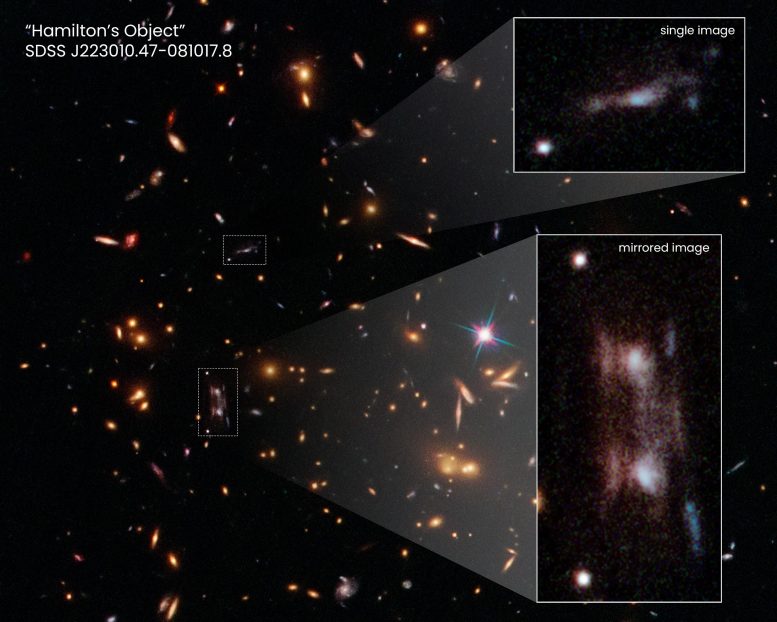‘Double’ Galaxy Mystifies Hubble Astronomers – “We Were Really Stumped”

This Hubble Space Telescope snapshot shows three magnified images of a distant galaxy embedded in a cluster of galaxies. These images are produced by a trick of nature called gravitational lensing. The galaxy cluster’s immense gravity magnifies and distorts the light from the distant galaxy behind it, creating the multiple images. The galaxy cluster, catalogued as SDSS J223010.47-081017.8, is 7 billion light-years from Earth. Hubble has observed many gravitationally lensed galaxies. However, the images spotted in this Hubble snapshot are unique. Two of the magnified images, shown in the pull-out at bottom right, are exact copies of each other. The two bright ovals are the cores of the galaxy. This rare phenomenon occurs because the background galaxy straddles a ripple in the fabric of space. This “ripple” is an area of greatest magnification, caused by the gravity of dense amounts of dark matter, the unseen glue that makes up most of the universe’s mass. As light from the faraway galaxy passes through the cluster along this ripple, two mirror images are produced, along with a third image that can be seen off to the side. A close-up of the third image is shown in the pull-out at top right. This image most closely resembles the remote galaxy, which is located more than 11 billion light-years away. Based on a reconstruction of this image, the researchers determined that the distant galaxy appears to an edge-on, barred spiral with ongoing, clumpy star formation. The mirror images are named “Hamilton’s Object” for the astronomer who discovered them. Credit: Joseph DePasquale (STScI)
Gazing into the universe is like looking into a funhouse mirror. That’s because gravity warps the fabric of space, creating optical illusions.
Many of these optical illusions appear when a distant galaxy’s light is magnified, stretched, and brightened as it passes through a massive galaxy or galaxy cluster in front of it. This phenomenon, called gravitational lensing, produces multiple, stretched, and brightened images of the background galaxy.
This phenomenon allows astronomers to study galaxies so distant they cannot be seen other than by the effects of gravitational lensing. The challenge is in trying to reconstruct the distant galaxies from the odd shapes produced by lensing.
But astronomers using the ‘Double’ Galaxy Mystifies Hubble Astronomers – “We Were Really Stumped”
